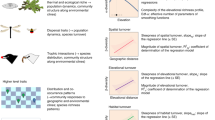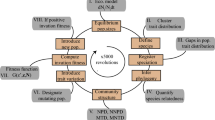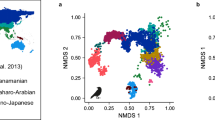Abstract
Niche conservatism—the tendency for closely related species to be ecologically similar—is widespread1,2,3. However, most studies compare closely related taxa that occur in allopatry3; in sympatry, the stabilizing forces that promote niche conservatism4,5, and thus inhibit niche shifts, may be countered by natural selection favouring ecological divergence to minimize the intensity of interspecific interactions6,7. Consequently, the relative importance of niche conservatism versus niche divergence in determining community structure has received little attention7. Here, we examine a tropical lizard community in which species have a long evolutionary history of ecological interaction. We find that evolutionary divergence overcomes niche conservatism: closely related species are no more ecologically similar than expected by random divergence and some distantly related species are ecologically similar, leading to a community in which the relationship between ecological similarity and phylogenetic relatedness is very weak. Despite this lack of niche conservatism, the ecological structuring of the community has a phylogenetic component: niche complementarity only occurs among distantly related species, which suggests that the strength of ecological interactions among species may be related to phylogeny, but it is not necessarily the most closely related species that interact most strongly.
This is a preview of subscription content, access via your institution
Access options
Subscribe to this journal
Receive 51 print issues and online access
$199.00 per year
only $3.90 per issue
Buy this article
- Purchase on Springer Link
- Instant access to full article PDF
Prices may be subject to local taxes which are calculated during checkout


Similar content being viewed by others
References
Peterson, A. T., Soberón, J. & Sánchez-Cordero, V. Conservatism of ecological niches in evolutionary time. Science 285, 1265–1267 (1999)
Prinzing, A., Durka, S., Klotz, W. & Brandl, R. The niche of higher plants: evidence for phylogenetic conservatism. Proc. R. Soc. Lond. B 268, 2383–2389 (2001)
Webb, C. O., Ackerly, D. D., McPeek, M. A. & Donoghue, M. J. Phylogenies and community ecology. Annu. Rev. Ecol. Syst. 33, 475–505 (2002)
Harvey, P. H. & Pagel, M. D. The Comparative Method in Evolutionary Biology (Oxford Univ. Press, Oxford, 1991)
MacArthur, R. H. Geographical Ecology (Princeton Univ. Press, Princeton, 1972)
Schluter, D. The Ecology of Adaptive Radiation. (Oxford Univ. Press, Oxford, 2000)
Silvertown, J., Dodd, M. & Gowing, D. Phylogeny and the niche structure of meadow plant communities. J. Ecol. 89, 428–435 (2001)
Losos, J. B. Integrative approaches to evolutionary ecology: Anolis lizards as model systems. Annu. Rev. Ecol. Syst. 25, 467–493 (1994)
Roughgarden, J. Anolis Lizards of the Caribbean: Ecology, Evolution, and Plate Tectonics (Oxford Univ. Press, 1995)
Jackman, T. R., Larson, A., de Queiroz, K. & Losos, J. B. Phylogenetic relationships and tempo of early diversification in Anolis lizards. Syst. Biol. 48, 254–285 (1999)
Schoener, T. W. & Schoener, A. Densities, sex ratios, and population structure in four species of Bahamian Anolis lizards. J. Anim. Ecol. 49, 19–53 (1980)
Reagan, D. P. Congeneric species distribution and abundance in a three-dimensional habitat: the rain forest anoles of Puerto Rico. Copeia, 1992, 392–403 (1992)
Leal, M., Rodríguez-Robles, J. A. & Losos, J. B. An experimental study of interspecific interactions between two Puerto Rican Anolis lizards. Oecologia 117, 273–278 (1998)
Losos, J. B. & Spiller, D. Differential colonization success and asymmetrical interactions between two lizard species. Ecology 80, 252–258 (1999)
Gerber, G. P. & Echternacht, A. C. Evidence for asymmetrical intraguild predation between native and introduced Anolis lizards. Oecologia 124, 599–607 (2000)
Schoener, T. W. Resource partitioning in ecological communities. Science 185, 27–39 (1974)
Darwin, C. On the Origin of Species Ch. 3 (Murray, London, 1859)
Hutchinson, G. E. The Ecological Theater and the Evolutionary Play Ch. 2 (Yale Univ. Press, New Haven, 1965)
Petren, K., Grant, B. R. & Grant, P. R. A phylogeny of Darwin's finches based on microsatellite DNA length variation. Proc. R. Soc. Lond. B 266, 321–329 (1999)
Danley, P. D. & Kocher, T. D. Speciation in rapidly diverging systems: lessons from Lake Malawi. Mol. Ecol. 10, 1075–1086 (2001)
Richman, A. D. & Price, T. Evolution of ecological differences in the Old World leaf warblers. Nature 355, 817–821 (1992)
Butler, M. A. & Losos, J. B. Multivariate sexual dimorphism, sexual selection, and adaptation in Greater Antillean Anolis lizards. Ecol. Monogr. 72, 541–559 (2002)
Swofford, D. PAUP*: Phylogenetic Analysis Using Parsimony (*and Other Methods) (Sinauer, Sunderland, MA, 2002)
Huelsenbeck, J. P. & Ronquist, F. MRBAYES: Bayesian inference of phylogeny. Bioinformatics 17, 754–755 (2001)
Posada, D. & Crandall, K. A. Modeltest: testing the model of DNA substitution. Bioinformatics 14, 817–818 (1998)
Langley, C. H. & Fitch, W. An estimation of the constancy of the rate of molecular evolution. J. Mol. Evol. 3, 161–177 (1974)
Rodríguez Schettino, L. The Iguanid Lizards of Cuba (Univ. Press Florida, Gainesville, 1999)
Macey, J. R. et al. Phylogenetic relationships among agamid lizards of the Laudakia caucasia species group: testing hypotheses of biogeographic fragmentation and an area cladogram for the Iranian Plateau. Mol. Phylogenet. Evol. 10, 118–131 (1998)
Shochat, D. & Dessauer, H. C. Comparative immunological study of albumins of Anolis lizards of the Caribbean islands. Comp. Biochem. Physiol. 68A, 67–73 (1981)
de Queiroz, K., Chu, L.-R. & Losos, J. B. A second Anolis lizard in Dominican amber and the systematics and ecological morphology of Dominican amber anoles. Am. Mus. Nat. Hist. Novitates 3249, 1–23 (1998)
Acknowledgements
We thank J. Chase, R. Ricklefs and T. Schoener for comments, and V. Rivalta González, A. Daniel Alvarez, and A. Torres Barboza for assistance in the field. We thank the National Geographic Society, the David and Lucile Packard Foundation, the National Science Foundation and Barnard College for support.
Author information
Authors and Affiliations
Corresponding author
Ethics declarations
Competing interests
The authors declare that they have no competing financial interests.
Supplementary information
Rights and permissions
About this article
Cite this article
Losos, J., Leal, M., Glor, R. et al. Niche lability in the evolution of a Caribbean lizard community. Nature 424, 542–545 (2003). https://doi.org/10.1038/nature01814
Received:
Accepted:
Issue Date:
DOI: https://doi.org/10.1038/nature01814
This article is cited by
-
A trade-off between space exploration and mobilization of organic phosphorus through associated microbiomes enables niche differentiation of arbuscular mycorrhizal fungi on the same root
Science China Life Sciences (2023)
-
Factors underlying bird community assembly in anthropogenic habitats depend on the biome
Scientific Reports (2022)
-
Phylogenetic uncertainty and the inference of patterns in community ecology and comparative studies
Oecologia (2021)
-
Heterogeneous relationships between rates of speciation and body size evolution across vertebrate clades
Nature Ecology & Evolution (2020)
-
Divergent trends in functional and phylogenetic structure in reptile communities across Africa
Nature Communications (2018)
Comments
By submitting a comment you agree to abide by our Terms and Community Guidelines. If you find something abusive or that does not comply with our terms or guidelines please flag it as inappropriate.



